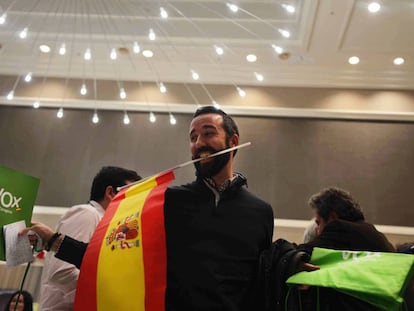How Spain’s far-right Vox created a winning social media strategy
The anti-immigration party has more followers on Instagram than any other political group in the country

Traffic to Vox’s website and social media platforms has soared following the recent elections in Andalusia, where the far-right party garnered 10.97% of the votes and 12 seats in the regional parliament.
Their Instagram account depicts the world in terms of good people and bad people
César Calderón, political consultant
There are three individuals between the ages of 23 and 26 who are largely responsible for the fact that Vox’s Twitter, Facebook and particularly Instagram accounts have started attracting huge numbers: a journalist, a sociologist and a broadcast studies undergraduate who were hired between 2016 and 2018 to pump up the party’s online profile. “There’s no longer any trust in the press,” says Manuel Mariscal, head of the party’s online accounts. “We are turning into our own communications channel.”
This is nothing new. It is a tried-and-tested populist strategy that proved effective in getting Donald Trump, Brazil’s Jair Bolsonaro and Italy’s Matteo Salvini into power.
1. The website
Voxespana.es had 59,941 visitors in January 2018, according to data from SimilarWeb, one of the internet’s main traffic monitors. At the start of the year, it trailed behind the Socialist Party (PSOE), Ciudadanos and Podemos, only beating the Popular Party (PP).
But by September, Vox was ahead of all its rivals with 223,017 visits. Then, following a rally in Madrid in October that attracted 9,000 Vox supporters, that number tripled to 612,658. “The people at Vox are experts at managing the new communications model,” says César Calderón, a political consultant and CEO of Redlines, which has collaborated with the PSOE, Ciudadanos and the PP. “The look is amateur because they are seeking to maximize their investment in the message and design.”
Unlike the webpages of the other parties, Vox’s site is simplicity itself. The page has a straightforward navigation bar where their proposals are plain for all to see: rolling back the law against gender violence; the deportation of illegal migrants, and the elimination of the sistema autonómico, or the decentralized system that currently grants many devolved powers to regional governments.
2. Instagram

Vox is way ahead of the other parties when it comes to Instagram, which was the fastest-growing platform in 2018, according to a report from the Spanish Digital Communication Association. It is also the platform which attracts most 16- to 30-year-old users.
Vox set up an Instagram account in April 2016. The Spanish flag, the unity of Spain and their feelings toward Catalan separatists were in evidence from the get-go. The photographs are unedited and unsophisticated and seek to appeal to the younger generation, who are directly addressed with messages such as, “Student! Don’t give up during Selectividad [university access exams]! You’re doing Spain a great service just by studying.” But the post that got the most ‘likes’ is a video in which Vox attacks the leftist party Podemos.
According to Gustavo Entrala, who set up the pope’s Twitter account, the amateur approach also lends them more credibility. And despite the fact that the average Vox voter is male, 68% of their traffic on Instagram is female.
“The platform depicts the world in terms of good people and bad people,” says Calderón. “It’s perfect for this style of communication. Particularly its stories: these are 15-second posts that don’t allow for gray areas.”
3. Facebook
Facebook is Spain’s favorite social media platform with more than 20 million users. Vox has 201,000 followers, which is fewer than either Ciudadanos or Podemos. Around 65% of Vox followers are men, and more than half of these are over 45.
Vox proposals

“Once more the kind of extremism that hates our freedom and is unable to coexist with us has stained the streets of Europe with blood. Drastic measures need to be taken across Europe. Vox proposes the following for Spain:”
- Close down extremist mosques
- Expel Imams who promote fundamentalism, the subjugation of women and Jihad
- Ban the building of mosques that spread Wahabi or Salafist or any other extreme ideologies
- Ban the funding of places of worship within Spain by third countries
- Demand that Islamic authorities in Spain collaborate fully to identify extremists
- Strengthen our borders and build an insurmountable wall in Ceuta and Melilla
- Give the police and the armed forces resources, human and otherwise, to control Spain's borders effectively along with the relevant legal protection.
- Increase and rationalize the defense budget
Their strategy is to publish short videos that last under a minute. During the Andalusian elections, they launched a campaign called #EspañaViva, reaching out to all age groups with clips like this one: “I’m Sylvia, I’m a housewife and I’m 40 years old. If it weren’t for my in-laws, we would not have managed. But there are many Andalusians like me. The only solution for Spain is Vox.”
Facebook and Instagram are Vox’s main focus when it comes to advertising investment. “We invested for the Madrid rally because it wasn’t advertised in the press. We’ve done the same in Andalusia,” says a party source without going into exactly how much was spent.
The advertising fees on Facebook vary according to the campaign’s target audience. It costs around €5,000 to get a video to reach 100,000 people, for example. The party has since launched other campaigns, the latest coming in the wake of the Strasbourg attack last week. “Extremism is leaving bloodstains on our streets,” it said. “We will increase the defense budget.”
Podemos also has several ongoing campaigns but the other parties have none.
Vox enjoyed its biggest surge of support a year ago. “It rose by 27%,” says Laura Muñoz, a social media analyst for Prisa News. “Since then, their strategy has been more proactive.”
The party promises to eliminate the administrative divisions known as “autonomous regions” if they get into power. That is why it only uses province-wide Facebook pages such as Vox Madrid, which has 30,000 followers. Most Vox supporters, however, are based in the south of Spain. These provincial Vox pages are run by volunteers. The logic is that by creating small sites, there is more interaction with supporters and the content is more relevant to the target audience. Consequently, they reach more people.
4. WhatsApp
WhatsApp is the most popular messaging platform in Spain. Vox used it during the Andalusian election to send mass messages directly to its supporters, according to the El Confidencial news site.
The strategy involves advertising a cellphone number that followers can add to their contacts. They then receive Vox’s messages direct to their phone. “You will be kept up to date with our activities. Share it with your contacts.”
The party began to reel in followers on WhatsApp in June. Within the first few days they had 2,000. Now, those who are in the groups prefer to keep the fact a secret. Calderón sees Vox’s WhatsApp strategy as accounting for much of its success. “They ask those who receive their messages to take an active role, to share the messages with friends – unlike the passive role assigned by other parties. It’s not a new approach. It was already used by the far-right candidate Jair Bolsonaro during Brazil’s presidential campaign.”
5. YouTube
Vox’s YouTube account was set up on January 15, 2014, one week after Podemos launched theirs. They now have 60,000 subscribers – more than any other parties apart from Podemos, which has 77,179. Their 1,200 videos have been viewed more than 10 million times. The same tactic is employed here with messages that are short and direct, such as, “Spain first” or “Defend Spain!” Entrala says, “Male conservatives have turned YouTube into their stronghold: they look for videos they can’t find on traditional media sites.”
6. Twitter
Twitter was Vox’s first social media account. It was opened in 2013, but according to a Vox spokesman, “we’re no longer interested in it. We’re going for Facebook and Instagram.”
The strategy here consists of tweeting just several times a day and retweeting messages from right-wing journalists and news sites. For example, this week they tweeted: “50 hooded separatists tried to disrupt a Vox event in Barcelona. Not one complaint from Pablo Iglesias, who is quiet as a rat in Galapagar.”
Of all the parties, Vox has the least followers on Twitter, which is the social media platform that most Spaniards dropped in 2018. Meanwhile, Vox set up a Telegram account this Tuesday that now has 6,219 followers.
7. Links to far-right media
Many of the news stories shared by Vox come from casoaislado.com, a far-right website that was set up in 2017 with xenophobic news that frame foreigners as the enemy. “Santiago Abascal’s party will drive up the demographics in Spain without the need for immigrants,” it promises, alluding to the low birth rate.
Vox has turned Spanish politics on its head and it is here to stay, according to experts. “Spain is just months away from a big election year. And as the Americans discovered during their own presidential election, there is no use in just ridiculing Vox or labeling them right-wing extremists or fascists,” says Calderón. “They have to be challenged on the actual policies that they are proposing.”
Trump and Bolsonaro’s winning formula
Jair Bolsonaro did not stand a chance on national television. Brazil's election law, designed to favor the politicians with the most power, had only allotted him seven seconds to promote his presidential campaign, illustrating how he was an isolated MP on the far right, without political allies within the country.
Meanwhile, his rivals from the traditional parties were given minutes-long slots in which to sell their policy proposals. But no one took into account that Bolsonaro had eight million followers on Facebook, Brazil's favorite platform – more than any of them.
Using live videos and memes, his message emerged triumphant. He also used Brazil's other favorite social media platform, WhatsApp. In a country with 147 million voters, 120 million use WhatsApp daily and most of those use it up to 30 times a day.
Suddenly, 81% of his supporters were using WhatsApp while only 59% of his rival Fernando Hadda's followers were doing the same, according to the Datafolha institute.
As 90% of Brazilians use WhatsApp groups to talk politics, Bolsonaro's team began to bombard them with content, including memes and extreme right-wing messages, which the database agencies made sure reached thousands of cellphone numbers. Soon they had conquered the app. An investigation run by Folha accused a number of companies of investing more than €2.8 million to create fake news in Bolsonaro's favor.
It was a copy of Donald Trump's own winning strategy at the 2016 presidential campaign: namely to saturate the market with messages. Trump's team produced up to 50,000 daily variations of each ad, according to information obtained from each of the millions of Facebook users.
English version by Heather Galloway.
Tu suscripción se está usando en otro dispositivo
¿Quieres añadir otro usuario a tu suscripción?
Si continúas leyendo en este dispositivo, no se podrá leer en el otro.
FlechaTu suscripción se está usando en otro dispositivo y solo puedes acceder a EL PAÍS desde un dispositivo a la vez.
Si quieres compartir tu cuenta, cambia tu suscripción a la modalidad Premium, así podrás añadir otro usuario. Cada uno accederá con su propia cuenta de email, lo que os permitirá personalizar vuestra experiencia en EL PAÍS.
¿Tienes una suscripción de empresa? Accede aquí para contratar más cuentas.
En el caso de no saber quién está usando tu cuenta, te recomendamos cambiar tu contraseña aquí.
Si decides continuar compartiendo tu cuenta, este mensaje se mostrará en tu dispositivo y en el de la otra persona que está usando tu cuenta de forma indefinida, afectando a tu experiencia de lectura. Puedes consultar aquí los términos y condiciones de la suscripción digital.
More information
Archived In
Últimas noticias
Most viewed
- Alain Aspect, Nobel laureate in physics: ‘Einstein was so smart that he would have had to recognize quantum entanglement’
- David King, chemist: ‘There are scientists studying how to cool the planet; nobody should stop these experiments from happening’
- Maps of the US attack on Venezuela: Targets, airspace and deployed fleet
- Key points of the military attack on Venezuela: Early morning bombings and a ‘captured’ president
- Trump says Washington will control Venezuela until there is ‘a safe transition’










































